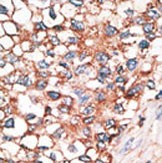GJA10 Antibody (C-term)
Purified Rabbit Polyclonal Antibody (Pab)
- SPECIFICATION
- CITATIONS: 1
- PROTOCOLS
- BACKGROUND

Application
| IHC-P, WB, E |
|---|---|
| Primary Accession | P57773 |
| Reactivity | Human, Mouse |
| Host | Rabbit |
| Clonality | Polyclonal |
| Isotype | Rabbit IgG |
| Calculated MW | 58842 Da |
| Antigen Region | 484-515 aa |
| Gene ID | 81025 |
|---|---|
| Other Names | Gap junction alpha-9 protein, Connexin-58, Cx58, Connexin-59, Cx59, Gap junction alpha-10 protein, GJA9, GJA10 |
| Target/Specificity | This GJA10 antibody is generated from rabbits immunized with a KLH conjugated synthetic peptide between 484-515 amino acids from the C-terminal region of human GJA10. |
| Dilution | IHC-P~~1:50~100 WB~~1:1000 E~~Use at an assay dependent concentration. |
| Format | Purified polyclonal antibody supplied in PBS with 0.09% (W/V) sodium azide. This antibody is prepared by Saturated Ammonium Sulfate (SAS) precipitation followed by dialysis against PBS. |
| Storage | Maintain refrigerated at 2-8°C for up to 2 weeks. For long term storage store at -20°C in small aliquots to prevent freeze-thaw cycles. |
| Precautions | GJA10 Antibody (C-term) is for research use only and not for use in diagnostic or therapeutic procedures. |
| Name | GJA9 |
|---|---|
| Synonyms | GJA10 |
| Function | One gap junction consists of a cluster of closely packed pairs of transmembrane channels, the connexons, through which materials of low MW diffuse from one cell to a neighboring cell. |
| Cellular Location | Cell membrane; Multi-pass membrane protein. Cell junction, gap junction |
| Tissue Location | Highly abundant in skeletal muscle. Also detected in testis. |

Provided below are standard protocols that you may find useful for product applications.
Background
GJA8 is a an integral membrane protein that belongs to the connexin family, alpha-type (group II) subfamily. One gap junction consists of a cluster of closely packed pairs of transmembrane channels, the connexons, through which materials of low MW diffuse from one cell to a neighboring cell. A connexon is composed of a hexamer of connexins.
References
Hombach S, et al., Eur J Neurosci. 2004 May;19(10):2633-40.
Houghton FD, et al., Biol Reprod. 2002 May;66(5):1403-12.
Manthey D, et al., J Biol Chem. 1999 May 21;274(21):14716-23.
If you have used an Abcepta product and would like to share how it has performed, please click on the "Submit Review" button and provide the requested information. Our staff will examine and post your review and contact you if needed.
If you have any additional inquiries please email technical services at tech@abcepta.com.














 Foundational characteristics of cancer include proliferation, angiogenesis, migration, evasion of apoptosis, and cellular immortality. Find key markers for these cellular processes and antibodies to detect them.
Foundational characteristics of cancer include proliferation, angiogenesis, migration, evasion of apoptosis, and cellular immortality. Find key markers for these cellular processes and antibodies to detect them. The SUMOplot™ Analysis Program predicts and scores sumoylation sites in your protein. SUMOylation is a post-translational modification involved in various cellular processes, such as nuclear-cytosolic transport, transcriptional regulation, apoptosis, protein stability, response to stress, and progression through the cell cycle.
The SUMOplot™ Analysis Program predicts and scores sumoylation sites in your protein. SUMOylation is a post-translational modification involved in various cellular processes, such as nuclear-cytosolic transport, transcriptional regulation, apoptosis, protein stability, response to stress, and progression through the cell cycle. The Autophagy Receptor Motif Plotter predicts and scores autophagy receptor binding sites in your protein. Identifying proteins connected to this pathway is critical to understanding the role of autophagy in physiological as well as pathological processes such as development, differentiation, neurodegenerative diseases, stress, infection, and cancer.
The Autophagy Receptor Motif Plotter predicts and scores autophagy receptor binding sites in your protein. Identifying proteins connected to this pathway is critical to understanding the role of autophagy in physiological as well as pathological processes such as development, differentiation, neurodegenerative diseases, stress, infection, and cancer.


